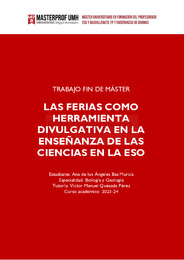Please use this identifier to cite or link to this item:
https://hdl.handle.net/11000/32659Full metadata record
| DC Field | Value | Language |
|---|---|---|
| dc.contributor.advisor | quesada, victor | - |
| dc.contributor.author | Bas Murcia, Ana de los Ángeles | - |
| dc.contributor.other | Departamentos de la UMH::Ciencias Sociales y Humanas | es_ES |
| dc.date.accessioned | 2024-07-23T12:25:04Z | - |
| dc.date.available | 2024-07-23T12:25:04Z | - |
| dc.date.created | 2024-06 | - |
| dc.identifier.uri | https://hdl.handle.net/11000/32659 | - |
| dc.description | Especialidad: Biología y Geología | es_ES |
| dc.description.abstract | La divulgación científica es una herramienta clave para el intercambio de saberes y por tanto para el enriquecimiento científico-cultural de la etapa estudiantil. A día de hoy, hay gran cantidad de técnicas divulgativas como puede ser el uso de elementos audiovisuales, blogs, talleres, proyectos, ferias, etc. Esta revisión se ha centrado en el uso de ferias como elemento didáctico de divulgación científica aplicando un aprendizaje basado en problemas o proyectos. De este modo los estudiantes son los encargados de crear un proyecto y exponerlo al público. El objetivo principal de esto es fomentar el trabajo autónomo y que el alumnado no sea receptor pasivo de la información, sino que acabe compartiendo conocimiento de forma activa. El proyecto seleccionado para exponer en una feria ha sido el de realizar el experimento de T. H. Morgan con Drosophila melanogaster en el laboratorio escolar durante una duración de 8 sesiones para luego darlo a conocer en un stand | es_ES |
| dc.description.abstract | Scientific dissemination is a key tool for the exchange of knowledge and therefore for the scientific-cultural enrichment of the student stage. Today, there are a large number of informative techniques such as the use of audiovisual elements, blogs, workshops, projects, fairs, etc. This review has focused on the use of fairs as a didactic element of scientific dissemination applying problem- or project-based learning. In this way, students are in charge of creating a project and exposing it to the public. The main objective of this is to encourage autonomous work and for students to not be passive recipients of information, but to end up actively sharing knowledge. The project selected to be exhibited at a fair has been the application of Morgan's experiment with Drosophila melanogaster in the school laboratory for a duration of 8 sessions and then presented at a stand | es_ES |
| dc.format | application/pdf | es_ES |
| dc.format.extent | 19 | es_ES |
| dc.language.iso | spa | es_ES |
| dc.publisher | Universidad Miguel Hernández | es_ES |
| dc.rights | info:eu-repo/semantics/openAccess | es_ES |
| dc.rights | Attribution-NonCommercial-NoDerivatives 4.0 Internacional | * |
| dc.rights.uri | http://creativecommons.org/licenses/by-nc-nd/4.0/ | * |
| dc.subject | Divulgación | es_ES |
| dc.subject | Feria de ciencias | es_ES |
| dc.subject | Genética | es_ES |
| dc.subject | Aprendizaje basado en proyectos | es_ES |
| dc.subject | Aprendizaje basado en problemas | es_ES |
| dc.subject | Drosophila melanogaster | es_ES |
| dc.subject.other | CDU::3 - Ciencias sociales::37 - Educación. Enseñanza. Formación. Tiempo libre | es_ES |
| dc.title | Las ferias como herramienta divulgativa en la enseñanza de las ciencias en la ESO | es_ES |
| dc.type | info:eu-repo/semantics/masterThesis | es_ES |

View/Open:
TFM Bas Murcia, Ana de los Ángeles.pdf
1,04 MB
Adobe PDF
Share:
.png)
